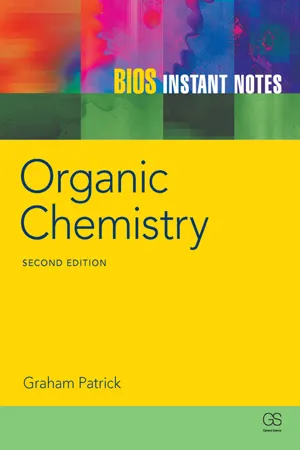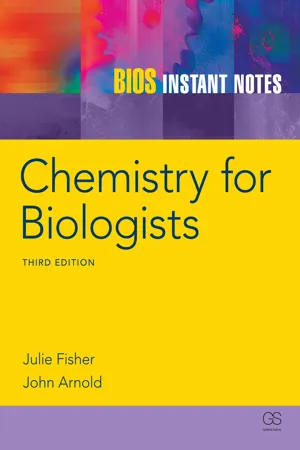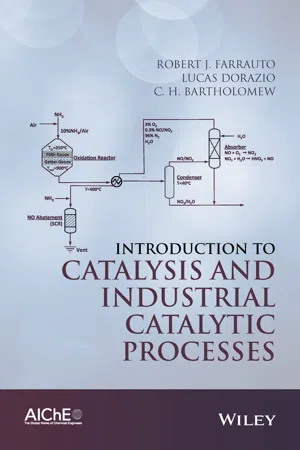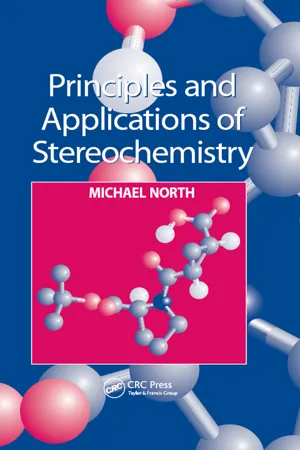Chemistry
Reactions of Cycloalkanes
Reactions of cycloalkanes involve various chemical transformations such as ring-opening reactions, substitution reactions, and addition reactions. These reactions can be influenced by factors such as ring strain and steric hindrance. Understanding the reactivity of cycloalkanes is important in organic chemistry for the synthesis of complex molecules and understanding the behavior of cyclic compounds.
Written by Perlego with AI-assistance
Related key terms
Related key terms
1 of 4
Related key terms
1 of 3
6 Key excerpts on "Reactions of Cycloalkanes"
- eBook - ePub
- Graham Patrick(Author)
- 2004(Publication Date)
- Taylor & Francis(Publisher)
n where the carbon atoms have been linked together to form a ring. All sizes of ring are possible. However, the most commonly encountered cycloalkane in organic chemistry is the six-membered ring (cyclohexane). Most cycloalkanes are unreactive to chemical reagents. However, small three- and four-membered rings are reactive and behave like alkenes. Such cyclic structures are highly strained since it is impossible for the carbon atoms to adopt their preferred tetrahedral shape.B2 Drawing structures
Key Notes
C–H Bond omission Alkanes can be drawn more quickly and efficiently if the C–H bonds are omitted. Skeletal drawings Skeletal drawings show only the C–C bonds. Each bond junction is assumed to have a carbon atom with sufficient hydrogens present to make up four bonds. Alkyl groups Alkyl groups (Cn H 2n +1) are alkane substituents of a more complex structure. They can be drawn as a skeletal drawing, or as CH3 , CH2 CH3 , et ceteraRelated topics (B1) Definition C–H Bond omission
There are several ways of drawing organic molecules. A molecule such as ethane can be drawn showing every C–C and C–H bond. However, this becomes tedious, especially with more complex molecules, and it is much easier to draw the structures if the C–H bonds are missing (Figure 1 ).Figure 1. Ethane.Skeletal drawings
A further simplification is often used where only the carbon-carbon bonds are shown. This is a skeletal drawing of the molecule (Figure 2 ). With such drawings, it is understood that a carbon atom is present at every bond junction and bond terminus, and that every carbon has sufficient hydrogens attached to make up four bonds.Straight chain alkanes can also be represented by drawing the C–C bonds in a zigzag fashion (Figure 3 ).Figure 2. Skeletal drawing of cyclohexane. Figure 3. Skeletal drawing of butane.Alkyl groups
Alkyl groups (Cn H2n +1) are alkane substituents of a complex molecule. Simple alkyl groups can be indicated in skeletal form (Figure 4a ), or as CH3 , CH2 CH3 , CH2 CH2 CH3 , et cetera . (Figure 4b - eBook - ePub
- James G. Speight(Author)
- 2019(Publication Date)
- Gulf Professional Publishing(Publisher)
Chapter 11Reactions of hydrocarbons
Abstract
An understanding of the chemical properties of the alkane derivatives is an important aspect of organic chemistry because of the many products derived from the hydrocarbon derivatives. Thus, it is the purpose of this chapter to present the simpler reactions—other more focused and complete texts are available for the readers who wish to gather more details.This chapter advises that, even though the thermal and catalytic decomposition of hydrocarbon derivatives can be represented by simple equations, it must always be remembered that the complexity of the individual reactions occurring in an extremely complex mixture and the interference of the products with those from other components of the mixture are unpredictable. Or the interference of secondary and tertiary products with the course of a reaction and, hence, with the formation of primary products may also be a cause for concern. Hence, caution is advised when applying the data from model compound studies to the behavior of crude oil, especially the molecularly complex heavy oils. These have few, if any, parallels in organic chemistry.Keywords
Alkylation; Catalytic decomposition; Dehydrocyclization; Dehydrogenation; Halogenation; Oxidation; Polymerization; Steam cracking; Thermal decomposition; Thermal reforming1. Introduction
Hydrocarbon derivatives and hydrocarbon fuels (gas, liquid, and solid) are one of the Earth's most important energy resources. The predominant use of hydrocarbon derivatives (individually or as fuels) is as a combustible fuel source. However, in addition, hydrocarbon fuels can be harnessed to create mechanical energy through combustion (Chapter 10 - eBook - ePub
- Jeffrey Gaffney, Nancy Marley(Authors)
- 2017(Publication Date)
- Elsevier(Publisher)
3 hybridized alkanes. The smaller cycloalkanes, cyclopropane and cyclobutane, have significant ring strain since the bond angles of 60 and 90 degrees are forced to be much smaller than 109.5 degrees. This makes them much less stable than the larger cycloalkanes.Fig. 13.9 The chemical structure of the simplest cycloalkanes containing three to six carbon atoms.Cyclic alkenes are also common, but only in larger ring sizes since the geometry of an sp 2 hybridized carbon is normally linear and smaller rings with very small bond angles would be extremely unstable. The cyclic alkenes have two sites of unsaturation, one from the double bond and one from the ring formation. Since they have lost a total of four hydrogens from the unsaturated alkane, they have the same molecular formula as the alkynes. So they are isomeric with the corresponding alkyne hydrocarbon having the same molecular formula.Another very important class of hydrocarbons is the aromatic hydrocarbons ; cyclic hydrocarbons composed of σ and π bonds are arranged in such a way that the electrons in the π bonds become delocalized giving the molecule unusual stability. Aromatic hydrocarbons originally received their name because many of the compounds have a sweet or pleasant odor. The simplest of the aromatic compounds is benzene, with a molecular formula of C6 H6 . All of the benzene carbon atoms have sp 2 hybridization, so the molecular geometry is planar. Benzene is a cyclohexane ring with three double bonds alternated with three single bonds. The alternating double bonds and single bonds in benzene are said to be conjugated. Conjugation - eBook - ePub
- J Fisher, J.R.P. Arnold, Julie Fisher, John Arnold(Authors)
- 2020(Publication Date)
- Taylor & Francis(Publisher)
Substitution reactions are those that involve the replacement of part of a molecule (an atom or group of atoms), with an incoming group. In some instances, it is necessary to activate the potential leaving group to make it a better leaving group and thus promote the substitution reaction. Substitution reactions are a feature of carboxylic acid chemistry and aromatic chemistry.Elimination reactionsElimination reactions occur with the loss of (generally) a small neutral molecule, from a larger molecule. These reactions are common with alkyl halides and alcohols, leading, in each case, to the formation of alkenes.Oxidation and reduction processesIn organic systems oxidation and reduction reactions are those that involve the gain or loss of oxygen, respectively. Reduction reactions can also involve the gaining of hydrogen; equivalent to the loss of oxygen. In many instances these processes involve free radicals. Oxidation and reduction reactions are features of the chemistry of almost all organic compounds, and are of great significance in biology.Related topics(A1) The periodic table (A2) Electron confgurationAddition reactions
An addition reaction is said to have occurred when a molecule has combined with another, without the loss of any part (atom or groups of atoms) of either molecule. There are two general classes of addition reaction that may be considered, nucleophilic and electrophilic addition (Section I1). For either type of addition reaction to occur one or more units of unsaturation - Robert J. Farrauto, Lucas Dorazio, C. H. Bartholomew(Authors)
- 2020(Publication Date)
- Wiley-AIChE(Publisher)
CHAPTER 9HYDROGENATION, DEHYDROGENATION, AND ALKYLATION9.1 INTRODUCTION
Selective catalytic hydrogenation of functional groups contained in organic molecules is one of the most useful, versatile, and environment-acceptable reaction routes available for organic synthesis. This important area of catalytic chemistry has been and continues to be the foundation for the development of numerous, diverse, largeand small-scale commercial hydrogenation processes, including (i) fine chemicals, (ii) intermediates for the pharmaceutical industry, (iii) monomers for the production of various polymers, and (iv) fats and oils for edible and nonedible products.Dehydrogenation reactions find a wide application in production of hydrogen, alkenes, polymers, and oxygenates. In recent years, the demand for light alkenes has grown dramatically due to increased demand for polypropylene, acrylonitrile, oxo alcohols, and propylene oxide. As a result, dehydrogenation of lower alkanes to alkenes is a rapidly expanding business.Alkylation allows smaller molecules to be coupled to for larger molecules mostly for petroleum applications.9.2 HYDROGENATION
9.2.1 Hydrogenation in Stirred Tank Reactors
With exception of a few continuous hydrogenation processes in petroleum refining, hydrogenation processes are often conducted in stirred tank reactors. This chapter focuses on hydrogenation occurring within stirred tank reactors, which are ideally suited and extensively used for liquid-phase hydrogenation reaction. For reactions where the hydrocarbon to be hydrogenated is in the liquid phase, stirred tank reactors are ideal. For hydrogenation, stirred tank reactors can be designed in two configurations, semibatch and continuous, which are illustrated in Figure 9.1- eBook - ePub
- Michael North(Author)
- 2017(Publication Date)
- Routledge(Publisher)
Scheme 9.29. The reader should beware, however, as many apparently[2π + 2π] cycloaddition reactions have actually been shown to occur by non-concerted radical mechanisms. Such reactions are not subject to the orbital overlap requirements of a cycloaddition and so may give products of different stereochemistry.9.6.4 Cheletropic reactionsCheletropic reactions are cycloaddition reactions in which both new σ-bonds are made to the same atom. The best known such reaction is the reaction between an alkene and a carbene to form a cyclopropane as shown inScheme 9.33. This reaction resembles a [2π + 2π] cycloaddition, yet it occurs thermally. The explanation for this reactivity is that since the LUMO of the carbene is localized on a single atom, it can react with the HOMO of the alkene in an orientation that would not be possible for the LUMO of an alkene as illustrated inFigure 9.8. The substituents on the carbene are initially parallel to the plane of the alkene, but as the new σ-bonds form they rotate to their final locations perpendicular to the plane of the alkene. AsFigure 9.8shows, the result is a syn-addition of the carbene to the alkene, arising from a suprafacial interaction between the HOMO and LUMO.Scheme 9.339.8 Orbital overlap during the cheletropic reaction between an alkene and a carbene. 9.7 Further reading GeneralStereochemistry of Organic Compounds E.L. Eliel and S.H. Wilen. Wiley: London, 1994, chapter 12.A Guidebook to Mechanism in Organic Chemistry P. Sykes. Longman: London, 1982.Stereoelectronic effects in reactionsStereoelectronic Effects in Organic Chemistry P. Deslongchamps. Pergamon: Oxford, 1983, chapters 5 and 6.Stereoelectronic Effects Oxford Chemistry Primer Number 36, A.J. Kirby. Oxford University Press: Oxford, 1996.Addition of nucleophiles to carbonyl compoundsAsymmetric Synthesis Vol. 2, E.L. Eliel ( J.D. Morrison ed.). Academic Press: London, 1983, chapter 5.Core Carbonyl Chemistry Oxford Chemistry Primer Number 47, J. Jones. Oxford University Press: Oxford, 1997.The aldol reactionStereoselective Synthesis
Index pages curate the most relevant extracts from our library of academic textbooks. They’ve been created using an in-house natural language model (NLM), each adding context and meaning to key research topics.
Explore more topic indexes
Explore more topic indexes
1 of 6
Explore more topic indexes
1 of 4





